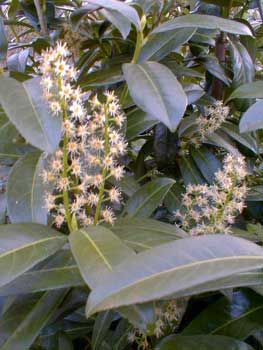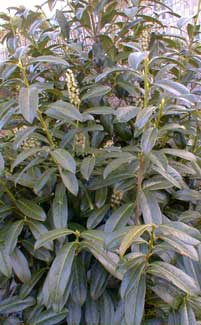
Bay Laurel; aka,
Greek Bay, Sweet Bay,
or Spanish Laurel
"Lay this laurel on the one
Too intrinsic for renown.
Laurel! veil your deathless tree,--
Him you chasten, that is he!"
-Emily Dickinson
(1830-1886)
(1830-1886)
Bay Laurel (Lauris nobilis) can sucker as a large multi-trunked bush, easily reaching fifteen feet in ten years or sooner, or suckers can be removed & it will slowly but surely reach 20 or 30 feet as a tree with as few as one trunk as trained. In its native Mediterranean setting it reaches sixty feet.
An old belief that bay laurel protects a house from the devil or from lightning is echoed in more northerly beliefs about holly trees, & it may well be true that old laurels (like hollies) can survive lightning strikes better than most trees & draw lightning away from shorter houses.
 Despite that it greatly wants to grow into a big specimen, it is commonly "hedged" in order to form a four to eight foot barrier. Such a large plant doesn't really like being maltreated in this manner, & I don't believe they ever quite make attractive hedges. Their flowers are rarely seen because the act of pruning such a hedge into an unnatural squared shape trims off the majority of buds.
Despite that it greatly wants to grow into a big specimen, it is commonly "hedged" in order to form a four to eight foot barrier. Such a large plant doesn't really like being maltreated in this manner, & I don't believe they ever quite make attractive hedges. Their flowers are rarely seen because the act of pruning such a hedge into an unnatural squared shape trims off the majority of buds.Our across-the-road neighbor didn't ask my opinion before she put in a row of young bay laurels which she said "would like nicer than a fence." I would've recommended something that doesn't want to be gigantic, or at least a dwarf laurel that wouldn't be trying to grow enormous. But once the deed was done, I began watching her hedge develop, & so far the row of shrubs has looked very nice.
Within their first year the tiny plants she put in were seven feet tall. Because Pam hasn't hedged them at all, they are at present very natural, very beautiful, & had their first full flowering in April 2005. Really they're very lovely at this stage. If Pam continues to let them grow as they prefer, they'll always be beautiful, but eventually she may want to cut down every other plant in the row as there's not room for them all to become trees. Again, it's not my home, & not my choice to make, but I've suggested she let them become flowering trees rather than turn them into boxed hedges, & I think I've sold her on that idea, though as they get bigger & bigger she may decide a trimmed hedge is what she prefers.
At this young stage, with no artificial shaping, I find them very beautiful, like pointed miniature trees, fully evergreen with big broad tough shiny green leaves. Another reason laurel hedges don't often look all that great is they actually prefer a moderate amount of shade or protection from afternoon sun, but hedges are typically placed on a roadside in full sun exposure. Pam's row of laurels is along an alleyway with large trees to the sunset side of the road, so this is really a great spot for flawless bay laurels. They do get somewhat stunted in full sun which perhaps makes them easier to hedge, but they just never achieve their full potential of beauty unless partially shaded.
Leaves of bay laurel are popular for kitchen use. They can be used fresh in soups, though the tough leaves will have to be picked out of the soup before serving, as they remain hard even with long boiling. Flavor is more concentrated if they are dried beforehand, & once dried they keep for months. If it is a burden to fish out all the bayleaves from a stew or soup before serving, dried leaves are easily broken up to fit inside a stainless steel tea-ball, perhaps mixed with woody spices such as whole cloves or star anise or curls of cinnamon bark, all removable in a teaball or two.
An oil obtained from the berries was formerly a popular liniment for aches & pains & arthritis, but it had no actual medicinal value & seemed to work because of the attendant massage. Bayberry oil is still used to scent candles & soap.
Bay Laurel is alternatively called Spanish Laurel because it is from the Mediterranean region, though not just from Spain, & curiously it is known in Spanish-speaking Carribean countries as "American Laurel" perhaps because it is more popular here & cultivated forms were developed in the States.
It likes deep watering to get started, but wants to dry out entirely between waterings. It becomes somewhat drought-hardy when long established, especially here in the Northwest where rainfall is sufficient except at high summer. They require very well draining soil or they're at some risk of rotting out during wet winters. They don't like temperatures below 20 degrees Fahrenheit, but usually bounce back from mild winter damage come spring. In a protected spot where winter winds cannot hamper it, it does very well around Puget Sound & other mellow Northwest locations. Wherever it is protected both from summer sunburn & winter wind-burn it will look fresh year-round.
This is the laurel of Greek mythology, sacred to Apollo, & fashioned into a crown for victorious athletes & scholars, remaining down to the modern age a symbol of achievement.
 Apollo adopted the laurel as his sacred tree because he loved a nymph or Delphic tree-goddess named Daphne. She was indeed his first love, but as he pursued her, she turned into a laurel tree to escape his embrace, sworn as she was to virginity in the service of Apollo's sister Artemis. The statue shown on this page shows Daphne turning into a laurel tree as Apollo strives to grab her This was the last work of Gian Lorenzo Bernini (1598-1680).
Apollo adopted the laurel as his sacred tree because he loved a nymph or Delphic tree-goddess named Daphne. She was indeed his first love, but as he pursued her, she turned into a laurel tree to escape his embrace, sworn as she was to virginity in the service of Apollo's sister Artemis. The statue shown on this page shows Daphne turning into a laurel tree as Apollo strives to grab her This was the last work of Gian Lorenzo Bernini (1598-1680).Apollo was primarily a homosexual god & Artemis primarily a lesbian goddess. Ovid, possibly the first literary fantasist turning Greek myths into Roman short stories, tweaks the Greek homosexual theme in having a certain Leucippus disguise himself as a maiden in order to seduce Daphne, who did not like men. Apollo was jealous, & inspired the Artemis college of maidens to go on a swim in the River Ladon. When one among them refused to take her clothes off to leap into the river, they jestingly tore off her clothing intending to force her into the water. Horrified to discover their group had been infiltrated by a man, they tore him to pieces.
Now it seems fairly obvious that a gay god like Apollo would have been jealous not because he too loved Daphne, but because Leucippus had been unfaithful to Apollo. And it was after all Leucippus who was punished, much as Artemis punished those of her maiden nympths who were unfaithful.
So Ovid required an explanation for Apollo's lapse into heterosexuality. Eros, peevish either that Apollo loved only young men, or that Apollo insulted Eros as the least of all Olympians, shot Apollo in the heart with a sharp dart which caused him to become fascinated by Daphne. Eros simultaneously shot a blunted dart into the heart of Daphne so that she would never reciprocate Apollo's interest.
In some versions of Daphne's parentage, she is the twin sister of Hyacinthos, the boy loved by both Zeus & Apollo & whom Apollo accidentally killed, bringing hyacinths into existance from the young man's blood. Daphne was to Artemis as Hyacinthos was to Apollo.
In the "gender-bending" mythology which Daphne embodies, she is elsetimes said to have been the daughter of Teiresias, the blind Theban prophet who was turned into a woman for seven years, during which time "she" gave birth to two daughters, Daphne & Manto.
These unusual myths seem to come from maenad religion which was the feminine equivalent of orphism, & as orphism upraised Apollo with a misogynist hue disdainful of women, maenadism upraised virgin Cybele & lauded a symbolic notion made literal in myths, of women ripping men to pieces with their bare hands. And Cybele herself is a gender-bent divinity, whose byform Agdistis took the form of an almond tree (the almond being shaped like the vulva), & dropped one of her almonds into the lap of the river-nymph Nana, inducing the birth of another homosexual god, Dionysios, lord of Maeanads egging women onward to the destruction of masculine civilization.